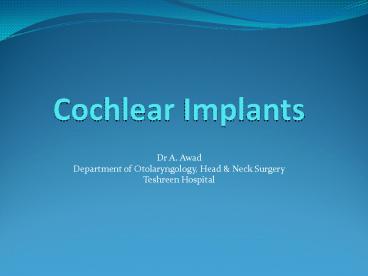Cochlear Implants - PowerPoint PPT Presentation
1 / 28
Title: Cochlear Implants
1
Cochlear Implants
- Dr A. Awad
- Department of Otolaryngology, Head Neck Surgery
- Teshreen Hospital
2
What is a cochlear implant
- Surgically implanted electronic device that can
help provide a sense of sound to a person who is
profoundly deaf, or severly hard of hearing - The cochlear implant is often referred to as
bionic ear - Unlike other kinds of hearing aids the cochlear
implants dose not amplify sound, but works by
directly stimulating any functioning auditory
nerves inside the cochlea with electrical
impulses
3
History of Cochlear Implants
- Alessandro Volta 1880
- Djourno and Eyries 1957
- House, Doyle, Simmons 1961
- 1972 Single-channel implant
- 1984 FDA approval,Nucleus22
- 2006, 120 000 implantations
4
Devices
- Advanced Bionics (US)
- Cochlear (Australia)
- Med-el (Austria)
- Neurelec (France)
- All hear (US) which is a single channal device.
Its not FDA approved.
5
Components
6
Components of Cochlear Implant
7
Anatomy
8
Indication for Cochlear Implant
- Adults
- 18 years old and older (no limitation by age)
- Bilateral severe-to-profound sensorineural
hearing loss (70 dB hearing loss or greater with
little or no benefit from hearing aids after 6
months trial) - Psychologically suitable
- No anatomic contraindications
- Medically not contraindicated
9
Indications for Cochlear Implantation --
Childrencurrent criteria
- 12 months or older
- Bilateral severe-to-profound sensorineural
hearing loss - No appreciable benefit with hearing aids after
3-6 months trial - Enrolled in aural/oral education program
- No medical or anatomic contraindications
- Motivated parents
10
General Workup
- Audiologic evaluation
- Medical evaluation
- Speech-language evaluation
- Psychological/rehabilitation evaluation
11
CT Findings
12
CT Findings
13
Contraindications
- Neurofibromatosis II, mental retardation,
psychosis, organic brain dysfunction, unrealistic
expectations - Active middle ear disease
- Perforation of TM
- CT findings of cochlear agenesis (Michel
deformity) or small IAC (CN8 atresia) - Dysplasia not necessarily a contraindication, but
informed consent is a must - CWD mastoidectomy
- Cochlear ossification
- Advanced otosclerosis
14
Risks of CI Surgery(ASHA technical Reports 2004)
- Injury to the facial nerve
- Post operative dizziness
- Meningitis
- Leakage of CSF
- Delayed device failure (less than 2)
- Device migration or extrusion (rare)
15
Special Instrumentation
- Metal Template
- Silicon Implant Template
- Bone recess template
- Array exit marking template
- Recess checking gauge
- Electrode claw
- Micro forceps with parallel tips
- Spacer for intraoperative testing
- Surgical burrs (0.6 mm-1.2 mm-3 mm)
- Facial nerve monitoring
16
Surgical Technique Incisions
17
Drill Implant Bed, Electrode Channel, Suture
Holes, And Mastoidectomy
18
Posterior tympanotomy
19
Posterior tympanotomy
20
Cochleostomy
21
Inserting The Electrode Array
22
Fixation Of The Implant
23
Post-op X-ray View
24
- Activation of the Device 4 to 6 weeks after
surgery - The programming of the external speech processor
is a procedure that must be repeated one week
later and then periodically thereafter
25
Results of Implantation
- Wide range of outcomes
- Improvement is long-term (Waltzman, et al. 5-15
yr f/u) - Implantation is cost effectiveeven in the
elderly (Francis, et al) - Research indicates recipe for success includes
- Short length of time from deafness to
implantation (Sharma showed lt3.5 years regain
normal latencies within 6 mos. After 7 years,
little plasticity remains) - Experience with language before onset of deafness
- Implantation before age six for prelingually
deafened children - Aural/oral education
- Highly motivated patients/parents
26
Results of Implantation
- Beadle, et al (2005)
- 30 profoundly deaf children
- at 10 years follow up
- 26 understood conversation without lip reading
- 18 used telephone with a familiar speaker
- At 10-14 years
- 19 were at secondary schools
- 6 in mainstream schools
- 7in specially schools
- 6 in schools for the deaf
- Govaerts, et al showed 90 of children implanted
lt2yo were integrated into mainstream vs. only
20-30 if implanted after age 4
27
References
- 1ASHA, http//www.asha.org/public/hearing/
treatment/cochlear_implant.htm - 2waltzman, s. and Shapiro, w. (2007 Cochlear
implants in adults. In Valente, Hosford-Dunn and
Roesser(eds) Audiology treatment. New York
Thieme Medical Publisher, Inc. - 3ASHA Technical Reports 2004
- 4ASHA Technical Reports 2004
- 5Sharma et al
- 6Int J Pediatric otorhinolaryngology, PubMed ID
10577804 - 7Acta otolaryngology PubMed ID 12701751
- 8Adapted from American Speech-Language-Hearing
association, 1997.
28
THANK YOU





![[PDF] DOWNLOAD EBOOK Made to Hear: Cochlear Implants and Raising Deaf PowerPoint PPT Presentation](https://s3.amazonaws.com/images.powershow.com/10132065.th0.jpg?_=202409170810)

























